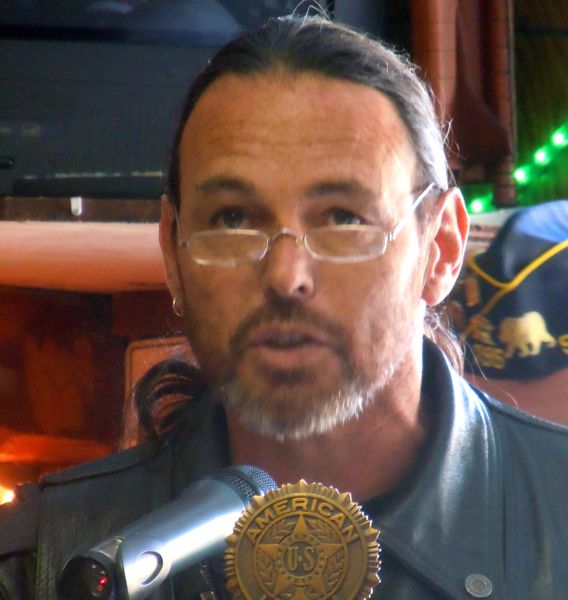EDC supe candidate spews hatred, bigotry
By Kathryn Reed
A business with the same SS logo used by the Nazis, posing with the Confederate flag and using it in another business, slamming gays and immigrants, saying there is no such thing as a transgender, and belonging to an outlaw motorcycle gang.
The above describes one of the candidates on the June 5 ballot for District 5 El Dorado County supervisor.
Kenny Curtzwiler is divisive for a lot of reasons. Often it’s not about his dark side, but more his assertions about myriad topics of which he professes to be well-versed but is often ill informed. Lake Tahoe News had to stop publishing his comments years ago when South Tahoe Public Utility District was his pet target because it required a correction nearly every time he hit send.
 There was a time when Curtzwiler’s Facebook page was full of hate. Much it has been scrubbed, but there are still inflammatory opinions there. It is his right to believe what he wants and to even write what he wants when it’s opinion and not stated as fact. It is also the public’s right to know as many facets of a candidate as possible.
There was a time when Curtzwiler’s Facebook page was full of hate. Much it has been scrubbed, but there are still inflammatory opinions there. It is his right to believe what he wants and to even write what he wants when it’s opinion and not stated as fact. It is also the public’s right to know as many facets of a candidate as possible.
A Facebook post from Feb 3, 2017, says, “If the Black Panthers can have an exhibit celebrating their heritage in Oakland why can’t the Confederates have an exhibit celebrating their heritage in South Lake Tahoe?? Don’t get your panties in a bunch people, it’s just a question?”
 Another post (date unknown) Curtzwiler posted a Fox News link with the headline “Democratic Rep. Frederica Wilson: White House ‘is full of white supremacists.’” Curtzwiler wrote: “Ok. I can live with that.”
Another post (date unknown) Curtzwiler posted a Fox News link with the headline “Democratic Rep. Frederica Wilson: White House ‘is full of white supremacists.’” Curtzwiler wrote: “Ok. I can live with that.”
This is the same person who when unsuccessfully running for supervisor in 2014 defended having said, “Yes I do collect unemployment on your dime and enjoy every powder day and have absolutely no regrets or ashamed of what I do.”
Curtzwiler works during the summer, then collects unemployment in the winter to help fund his “ski bum” lifestyle. At the time he told LTN in defense of his actions, “My company is a corporation and I am an employee of the company. I receive a paycheck and pay into EDD.”
This philosophy is in conflict with other posts on Facebook where he told someone to give up their citizenship and become an immigrant so they’d get kickbacks from the government faster.

From the Brotherhood motorcycle gang’s Facebook page.
On May 23 Curtzwiler emailed Lake Tahoe News stating, “I understand there are some questions being raised about my affiliation with a certain club. Rather than go through third parties you can ask me and if I feel the question is relevant rather than looking for dirt I will answer it.”
He could only have been alerted to this fact from the South Lake Tahoe Police Department because that is the only entity this reporter called regarding Curtzwiler’s affiliation with the Brotherhood motorcycle group.
The Brotherhood on its Facebook pages calls itself part of the 1 percenters. This designation, according to Police Chief Brian Uhler, puts them in the same category as the Hells Angels. Uhler also called the Brotherhood a gang.
While the local cops have not had any issues with members of the Brotherhood for a few years, drugs and assaults are part of their past.
Curtzwiler, according to Uhler, claims not to be part of the gang anymore. But with most gangs it’s not possible to just walk away. In other words, once a member always a member even if you don’t fly the colors.

Kenny Curtzwiler
Lake Tahoe News on May 27 emailed Curtzwiler a series of questions with the deadline being May 29. No response.
Here are the questions:
1. When did you first join the Brotherhood motorcycle group and why?
2. What is your affiliation with them now?
3. This is a self-described 1% motorcycle gang. The police describe it as a gang. Comment?
4. On social media you have posed with a Confederate flag and have one of your Ski Bum logos as a Confederate flag. Why? What are you trying to say? Most people see this as a symbol of racism. Do you? Why or why not?
5. On social media you have supported white supremacists, the KKK and Nazis. Why?
6. Your former business Lake Tahoe Custom Cycles had a logo of two S’s. The same logo as the Nazi Schutzstaffel, better known as the SS, of which the Gestapo was part of. Any comment?
7. On social media you have come out against gays and have said there is no such thing as a transgender. Why do you have hatred toward these people?
8. Why are you against immigrants?
9. How do you believe someone with such hatred toward so many groups of people will be able to represent those same people?
10. Why all the hatred?
Curtzwiler in 2012 and 2017 applied for a concealed weapons permit with the El Dorado County Sheriff’s Department. He was denied both times.
“Sorry, that information is not releasable,” Lt. Bryan Golmitz told Lake Tahoe News when asked why Curtzwiler was not given the permit.

